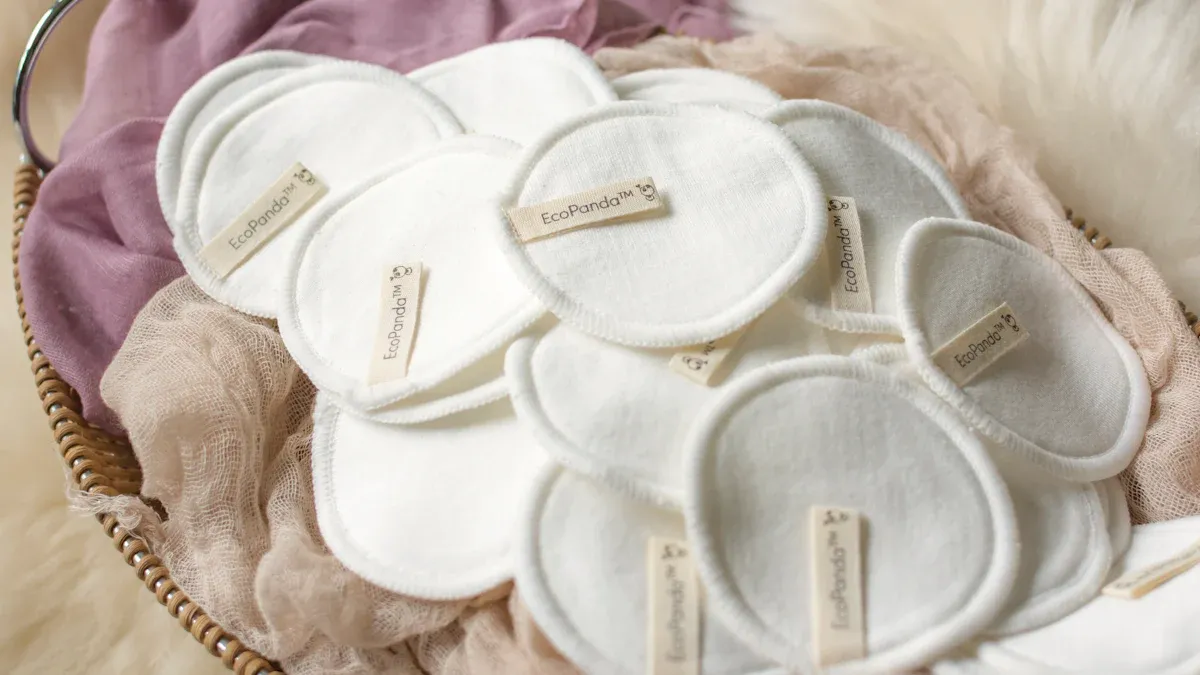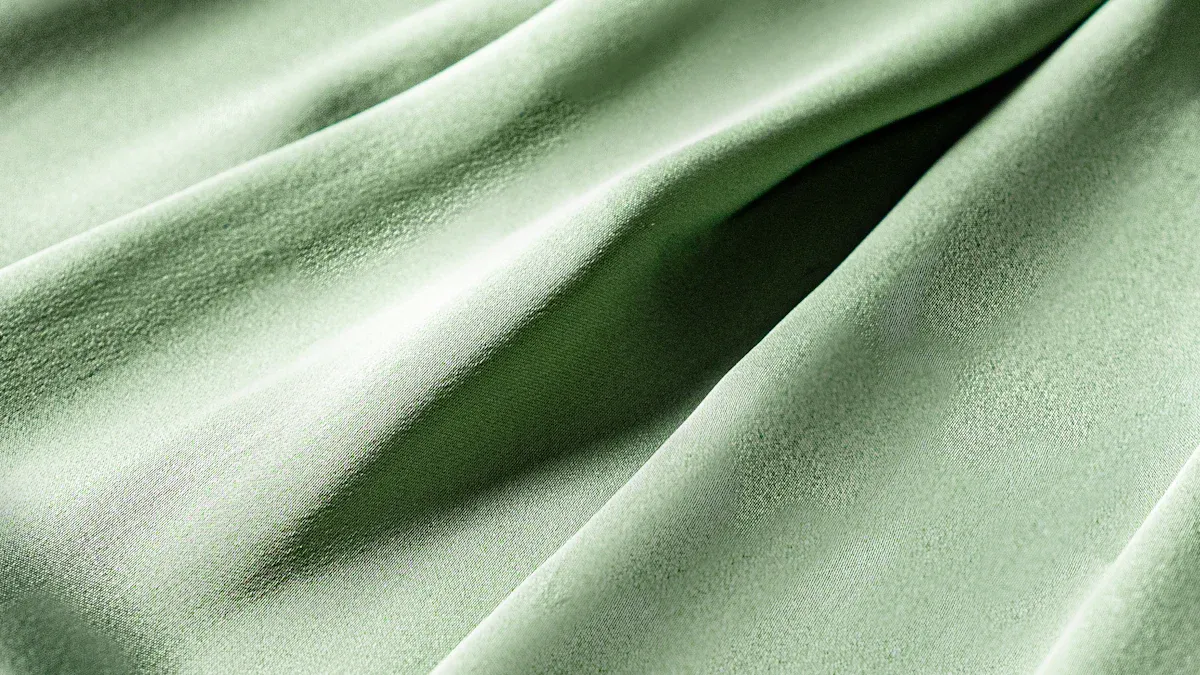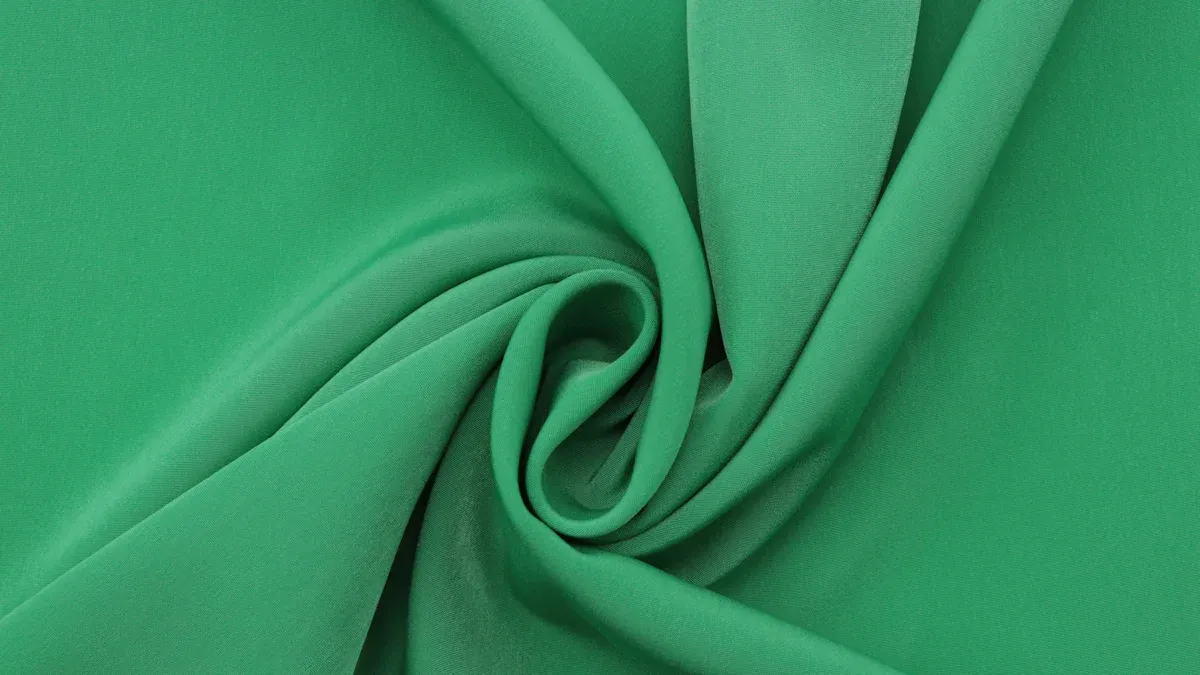
By choosing sustainable satin fabric, you actively contribute to protecting the environment. Sustainable satin fabric is crafted using fewer resources and incorporates eco-friendly materials into your wardrobe. Compared to traditional glass fiber fabrics, sustainable satin fabric often features a lower density, resulting in less waste and lighter products.
Opting for eco-friendly options like sustainable satin fabric helps reduce pollution and promotes smarter energy use.
| Property | Satin Weave Viscose Composites | Glass Fabric Composites | Comparative Insight |
|---|---|---|---|
| Density | Lower | Higher | Lighter, less waste |
| Work of Fracture | 40–60% higher | Baseline | Enhanced toughness |
By integrating sustainable satin fabric into your daily life, you make a meaningful impact by supporting sustainability and eco-friendly choices.
Key Takeaways
- Sustainable satin fabric uses eco-friendly materials and less water, energy, and chemicals, helping protect the environment.
- Choosing sustainable satin reduces pollution, lowers carbon emissions, and supports fair working conditions.
- Sustainable satin fabric breaks down naturally, reducing waste and keeping land and oceans cleaner.
- Brands like Suerte lead the way with quality, ethical production, and innovative technology in sustainable satin.
- Your choices matter: buying sustainable satin encourages the fashion industry to become greener and more responsible.
What Makes Sustainable Satin Fabric Different?
Defining Sustainable Satin Fabric
You want your fashion choices to matter. Sustainable satin fabric stands out because it meets strict environmental and social standards. To earn the label of sustainable satin fabric, the material must contain a high percentage of certified organic fibers. The Global Organic Textile Standard (GOTS) requires at least 70% organic fibers for a product to be called sustainable, and 95% for the “organic” grade. GOTS certification covers every step, from farming to manufacturing, and ensures no harmful chemicals or unfair labor practices are involved.
Sustainable satin fabric often uses blends like GOTS-certified silk and EcoVero viscose. EcoVero fibers, certified by the EU Ecolabel, use wood from responsibly managed forests and have up to 50% lower water use and carbon emissions than regular viscose. You can also look for certifications such as Oeko-Tex Standard 100, GRS, and Fair Trade. These marks show that sustainable fabrics are safe, ethical, and eco-friendly.
When you choose sustainable satin fabric, you support a cleaner planet and fair working conditions.
Key Differences from Conventional Satin
You may wonder how sustainable satin fabric compares to regular satin. The differences are clear and important:
- Conventional satin, especially polyester satin, is made from petroleum. It releases about 27 kg of CO2 for every kilogram produced and sheds microplastics into the environment.
- Sustainable satin fabric uses natural or certified fibers, which are biodegradable and produced with less energy.
- Conventional cotton satin uses more water and chemicals, leading to higher pollution and a bigger carbon footprint.
- Sustainable satin fabric avoids toxic dyes and harmful chemicals, protecting both you and the environment.
Textile production causes 20% of industrial water pollution, and washing synthetic fabrics releases microplastics equal to 50 billion plastic bottles each year. By choosing sustainable satin fabric, you help reduce these impacts. Sustainable fabrics set a new standard for fashion, making your choices powerful.
Environmental Benefits of Sustainable Satin Fabric

Reduced Water and Energy Use
You make a big difference when you choose eco-friendly fabrics. Sustainable satin fabric uses much less water and energy than traditional options. Many factories now use high-efficiency washers and optimized processes. These changes save up to 75% of water and about 20% of energy during production. The table below shows how much you can help the planet by supporting sustainable fabrics:
| Metric | Conventional Production | Sustainable/Optimized Production | Savings/Reduction (%) |
|---|---|---|---|
| Water consumption (L/kg fabric) | 28 to 285 (average 164) | Reduced by 45% to 75% via optimized washing | Up to 75% water savings |
| Wastewater generation (L/kg) | 119 | Reduced proportionally with water savings | N/A |
| Energy savings (steam use) | Baseline | Up to 20.2% reduction by lowering water use | 20.2% energy savings |
| Chemical consumption (g/kg) | Average 449 | Potential 10% reduction (~40 g/kg) | 10% chemical savings |
You also help cut down on harmful chemicals. Many sustainable fabrics use biobased dyes and safer chemicals. This means less pollution in rivers and less harm to people and animals. When you pick eco-friendly fabrics, you support cleaner water and a healthier world.
Lower Carbon Emissions and Pollution
You can lower your carbon footprint by choosing sustainable options. Traditional textile production releases a lot of carbon dioxide and other greenhouse gases. Sustainable satin fabric uses natural or recycled fibers and energy-saving methods. These steps reduce carbon emissions and keep the air cleaner.
- Organic sericulture and closed-loop water recycling help cut pollution.
- Factories in India and China have shown that using natural dyes and biodegradable chemicals leads to less waste and cleaner air.
- Peace silk, also called Ahimsa silk, lets silkworms live out their life cycle. This method is more humane and better for the environment.
Every time you choose eco-friendly fabrics, you help reduce pollution and protect the planet for future generations.
Biodegradability and Waste Reduction
You can help solve the problem of textile waste. Sustainable satin fabric often uses biodegradable fibers. These materials break down naturally, so they do not fill up landfills or pollute the ocean. Unlike synthetic fabrics, which can take hundreds of years to decompose, sustainable fabrics return to the earth much faster.
- Sustainable production methods use fewer chemicals and create less waste.
- Local communities benefit from cleaner water and healthier soil.
- Innovation in farming and waste management keeps improving the process.
When you support eco-friendly fabrics, you help reduce waste and keep the planet clean. Your choices matter. You have the power to make fashion better for everyone.
Sustainable Satin Fabric in Eco-Friendly Fashion

Supporting Responsible Production and Ethical Sourcing
You shape the future of sustainable fashion when you choose eco-friendly fabrics made with responsible production and ethical sourcing. Brands now use traceability tools so you can see where your fabric comes from and how it was made. This transparency builds trust and helps you avoid greenwashing. Companies select raw materials like GOTS-certified organic cotton, bamboo, and Tencel™ for their ecological benefits. They also work with partners who guarantee fair wages and safe working conditions. Certifications such as GOTS and OEKO-TEX® Standard 100 confirm that your satin fabric meets strict environmental and social standards. These independent audits and clear labels give you confidence in your choices.
When you support brands that value ethical sourcing, you help protect workers and the planet.
Leading Brands in Sustainable Satin Fabric (including Suerte)
You can find leading brands in the sustainable satin fabric market by looking at major industry events and market data. The 137th Canton Fair highlights top manufacturers, including Shaoxing Suerte Textile Co., Ltd. Suerte stands out for its advanced production equipment and strong focus on quality. The company meets global demand by offering a wide range of eco-friendly fabrics and adapting to new trends in sustainable fashion. Suerte’s commitment to responsible manufacturing and innovation positions it as a leader in the industry. The growing popularity of online platforms also makes it easier for you to discover and choose sustainable satin fabric from trusted brands.
- Suerte uses advanced machinery for consistent quality.
- The company offers quick response times and one-stop service for custom orders.
- Suerte’s eco-friendly approach aligns with the values of modern consumers.
The Role of Innovation in Sustainable Fabric Choices
You drive change in the textile industry by choosing eco-friendly fabrics that use the latest technology. Innovations in organic sericulture, non-chemical dyeing, and water-saving processes help reduce pollution and protect biodiversity. Companies now use AI-driven design software and automated looms to improve precision and cut waste. For satin fabrics, new weaving techniques and nanotechnology create materials that last longer and resist stains. These advances make sustainable fashion more accessible and appealing. When you pick innovative fabrics, you support a cleaner planet and enjoy products that combine beauty, durability, and responsibility.
The Impact of Sustainable Consumer Choices
Influencing Fashion Industry Standards
You have the power to shape the future of fashion. When you choose sustainable satin fabric, you send a clear message to brands and designers. Your choices push companies to improve their standards and offer better products. Many brands now focus on transparency, ethical sourcing, and eco-friendly materials because you demand it.
- Over half of US and UK consumers want the fashion industry to be sustainable.
- 38% of shoppers have switched brands based on environmental or social practices.
- 66% of millennials are willing to pay more for sustainable brands.
- The hashtag #sustainablefashion has grown fivefold in the US, showing that more people care about eco-friendly choices.
Fashion companies notice these trends. Major brands like H&M, Kering, and Nike have made strong commitments to sustainability. Many now use renewable materials, reduce packaging, and treat employees fairly. You help set these new standards every time you choose sustainable products.
| Benchmark Aspect | Evidence Detail |
|---|---|
| Market Size Growth | Sustainable fashion market valued at $6.5B, projected to reach $15B by 2030 |
| Growth Rate of Sustainable Products | Sustainable products grow 5.6 times faster than non-sustainable ones |
| Organic Clothing Segment Growth | 16.2% annual growth rate |
| Eco-Friendly Clothing Sales | Expected to add $1.57B to global sales by 2025 |
Making a Positive Difference with Every Purchase
Every purchase you make can help the planet. When you pick sustainable satin fabric, you support brands that care about the environment. You also help reduce waste, save water, and lower carbon emissions. Your choices inspire others to do the same.
- 46% of consumers worldwide have bought sustainable goods recently.
- 27% are willing to pay more for eco-friendly products.
- The second-hand clothing market is growing fast, expected to reach $77 billion by 2025.
- Social media posts about slow fashion and second-hand shopping keep rising, spreading awareness.
Your actions matter. By choosing sustainable satin fabric, you help create a cleaner, fairer world. You show brands and friends that caring for the planet is always in style.
You hold the power to make a real difference. Choosing sustainable satin fabric helps you protect the planet and support a better future. Every eco-friendly choice you make sends a strong message. You inspire others to care for the earth. 🌱
Start today. Pick sustainable satin fabric and help create a cleaner, healthier world for everyone.
FAQ
What makes satin fabric sustainable?
You choose sustainable satin fabric because it uses eco-friendly fibers and safe dyes. Certified processes protect workers and the planet. You support a cleaner world with every purchase.
Can sustainable satin fabric feel as soft as regular satin?
Yes! You enjoy the same luxurious softness and shine. Sustainable satin uses advanced weaving and high-quality fibers. You never sacrifice comfort for sustainability.
How do I care for sustainable satin fabric?
You keep your fabric beautiful by washing it gently in cold water. Air dry for best results. Avoid harsh chemicals. This care routine helps your fabric last longer and stay vibrant.
Why should I choose Suerte for sustainable satin fabric?
You benefit from Suerte’s advanced production, quick response, and one-stop service. You get high-quality, customizable fabrics that match your eco-friendly values. Suerte helps you make a positive impact.



